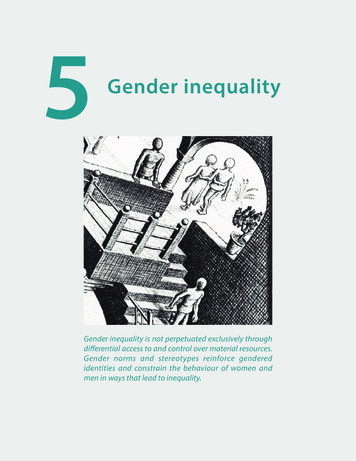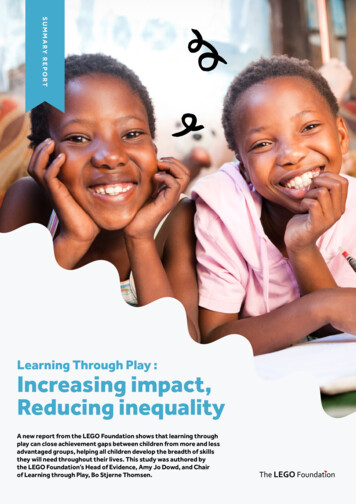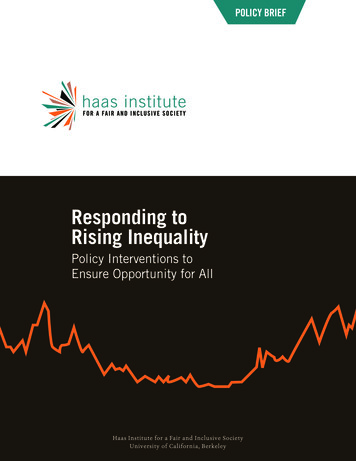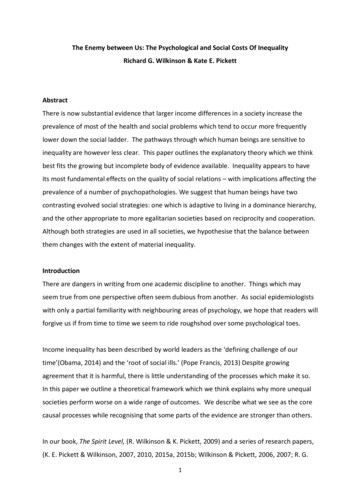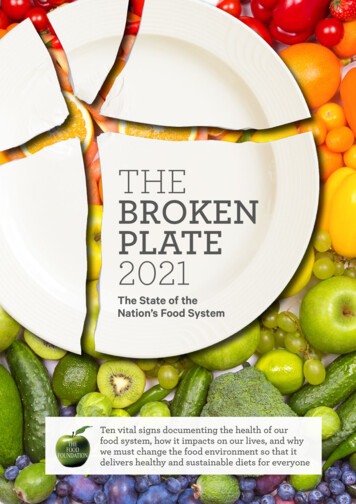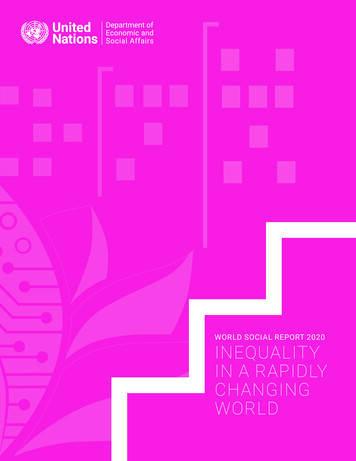
Transcription
WORLD SOCIAL REPORT 2020INEQUALITYIN A RAPIDLYCHANGINGWORLD
WORLD SOCIAL REPORT 2020DEPARTMENT OF ECONOMIC AND SOCIAL AFFAIRSWORLD SOCIAL REPORT 2020INEQUALITY IN A RAPIDLY CHANGING WORLD
INEQUALITY IN A RAPIDLY CHANGING WORLDDEPARTMENT OF ECONOMIC AND SOCIAL AFFAIRSThe Department of Economic and Social Affairs of the United Nations Secretariat is a vitalinterface between global policies in the economic, social and environmental spheres andnational action. The Department works in three main interlinked areas: (i) it compiles, generatesand analyses a wide range of economic, social and environmental data and information on whichStates Members of the United Nations draw to review common problems and to take stock ofpolicy options; (ii) it facilitates the negotiations of Member States in many intergovernmentalbodies on joint courses of action to address ongoing or emerging global challenges; and (iii)it advises interested Governments on the ways and means of translating policy frameworksdeveloped in United Nations conferences and summits into programmes at the country leveland, through technical assistance, helps build national capacities.NOTEThe designations employed and the presentation of the material in the present publicationdo not imply the expression of any opinion whatsoever on the part of the Secretariat of theUnited Nations concerning the legal status of any country or territory or of its authorities, orconcerning the delimitations of its frontiers. The term “country” as used in the text of thisreport also refers, as appropriate, to territories or areas. The designations of country groups inthe text and the tables are intended solely for statistical or analytical convenience and do notnecessarily express a judgement about the stage reached by a particular country or area in thedevelopment process. Mention of the names of firms and commercial products does not implythe endorsement of the United Nations. Symbols of United Nations documents are composedof capital letters combined with figures.ST/ESA/372United Nations publicationSales No. E.20.IV.1ISBN 978-92-1-130392-6eISBN 978-92-1-004367-0Copyright United Nations 2020All rights reservedI
IIWORLD SOCIAL REPORT 2020FOREWORDThe World Social Report 2020: Inequality in a rapidly changing world comes as weconfront the harsh realities of a deeply unequal global landscape. In North and Southalike, mass protests have flared up, fueled by a combination of economic woes,growing inequalities and job insecurity. Income disparities and a lack of opportunitiesare creating a vicious cycle of inequality, frustration and discontent across generations.The World Social Report 2020 documents deep divides within and across countriesdespite an era of extraordinary economic growth and widespread improvements inliving standards. The report also underscores how gender, along with ethnicity, race,place of residence and socioeconomic status, continue to shape the chances peoplehave in life.In some parts of the world, divides based on identity are becoming more pronounced.Meanwhile, gaps in newer areas, such as access to online and mobile technologies,are emerging. Unless progress accelerates, the core promise of the 2030 Agendafor Sustainable Development – to leave no one behind – will remain a still distant goalby 2030.The inequality challenge is global, and intimately connected to other pressing issues ofour times: not only rapid technological change, but also the climate crisis, urbanizationand migration. In many places, the growing tide of inequality could further swell underthe force of these megatrends.The World Social Report 2020 sends a clear message: the future course of these complexchallenges is not irreversible. Technological change, migration, urbanization and eventhe climate crisis can be harnessed for a more equitable and sustainable world, or theycan be left to further divide us.Governments are key players in creating more equitable societies, protecting the mostvulnerable from the negative effects of these trends and ensuring that their benefitsas well as adaption costs are broadly and equitably shared. But, in our increasinglyinterconnected world, the decisions of other countries can constrain nationalpolicy-making.International cooperation is more important than ever.
INEQUALITY IN A RAPIDLY CHANGING WORLDAs we enter a Decade of Action to achieve the Sustainable Development Goals, theUnited Nations system will be at the forefront of the fight against inequality, linkingglobal principles and policy know-how to local action.The start of the Decade of Action coincides with the seventy-fifth anniversary of theUnited Nations. To mark this important occasion, we are opening a global conversationon building the future we want. In a world of dramatic global changes, I encouragepeople to express their views on how enhanced international cooperation can help builda fair globalization.The World Social Report 2020 frames the debate on how to curb inequality in theseturbulent times. Together, we must challenge the status quo and take action to tackledeep-seated as well as emerging inequalities once and for all.António GuterresSecretary-Generalof the United NationsIII
IVWORLD SOCIAL REPORT 2020ACKNOWLEDGEMENTSThe World Social Report is the flagship publication on major social developmentissues of the Department of Economic and Social Affairs (DESA) of the United NationsSecretariat.The 2020 report was prepared by a team managed by Wenyan Yang in the Divisionfor Inclusive Social Development, under the guidance of Elliott Harris and Daniela Bas.The report’s core team, led by Marta Roig, included Maren Jiménez, Alex Julca, HiroshiKawamura, Martijn Kind, Yern Fai Lee, Jonathan Perry and Julie Pewitt. Valuable inputswere provided by other colleagues in DESA, including Astra Bonini, Clare Menozzi,Vinod Mishra and Shantanu Mukherjee. The team is grateful to Eduardo Moreno andhis team at UN-Habitat for their valuable inputs to chapter 4 of the report.The analysis contained in the report is based in part on background papersprepared by independent experts Aaron Benavot and Kathleen Newland. Thecollection and analysis of household survey data conducted by Bin Lian wasextremely important. Sabina Alkire, Corrine Mitchell and their team at the OxfordPoverty and Human Development Initiative graciously provided data on themultidimensional poverty index.The team is particularly grateful to Francisco Ferreira, Carlos Gradín, StephaneHallegatte, Kenneth Iverson, Alfredo Jefferson, Christoph Lakner, Hitoshi Osaka,Heriberto Tapia, Narasimha Rao, Julie Rozenberg and Brian Walsh for their guidanceand advice during the preparation of the report. The team would also like to thankJeni Klugman, Jorge Rodríguez as well as those DESA colleagues who providedcomments to the draft report during the formal review process.At an early stage, the team also benefited from consultations on new researchon inequality with Robert Andersen, Bea Cantillon, Lucas Chancel, Miles Corak,Hai-Anh Dang, Vidya Diwakar, Anirudh Krishna, Leslie McCall, Abigail McKnight,Pippa Norris, Celine Thévenot and Stephen Younger.The report was skillfully edited by Lois Jensen. Camilo Salomon provided the cover,publication and graphics design.
INEQUALITY IN A RAPIDLY CHANGING ry notesXIIExecutive summary2Introduction161. Inequality: where we stand today19Key messages20Introduction21A. Economic inequality211. Income inequality across countries222. Trends in economic inequality within countries26a. Regional trends26b. Labour and capital31c. The impact of policy32B. Inequality of opportunity341. Group-based disadvantage, poverty and income inequality372. Trends in group-based inequality40C. The price of inequality451. Slower economic growth and poverty reduction452. Limited upward mobility463. Captured political processes, mistrust of institutions and growing unrest48D. Conclusions52Annex 1: Measuring economic inequality53Annex 2: Group-based disparities in access to electricity and sanitation56V
VIWORLD SOCIAL REPORT 20202. The technological revolution: winners and losers57Key messages58Introduction59A. Technology, employment and inequality601. Labour-saving and skill-biased technologies612. Share of labour in national income: impacts of labour-saving technology633. Wage divergence: impacts of skill-biased technology65B. Current technological divides and opportunities for inclusion711. Technological divides and unequal access to basic services712. New technologies and financial inclusion733. New technologies in other sectors75C. Policy considerations3. Climate change: exacerbating poverty and inequality7881Key messages82Introduction83A. Climate change through an inequality lens841. Channels through which climate change exerts its effects84a. Livelihoods84b. Health and mortality85c. Agricultural production and food prices86d. Labour and economic productivity862. Determinants of the uneven impacts of climate change86B. Unequal exposure and impacts across countries88C. Unequal exposure and impacts within countries931. People living in poverty93a. Exposure93b. Susceptibility94c. Ability to cope and recover95
INEQUALITY IN A RAPIDLY CHANGING WORLD2. Other vulnerable groups97a. Smallholder farmers97b. Indigenous peoples97c. Rural coastal populations98D. Distributional effects of climate action: implications for policy991. The effect of mitigation and adaptation policies on inequality99a. Mitigation policies99b. Adaptation policies1012. Promoting a just transition with equitable outcomes104a. A systems perspective105b. Climate action and social protection1054. Urbanization: expanding opportunities but deeper divides107Key messages108Introduction109A. Spatial inequalities: the rural-urban divide109B. An increasingly urban world1141. Inequality within cities: economic, spatial and social dimensions1152. Slums: home to more than 1 billion people119C. Policy implications: shared prosperity or rising inequality?1221. Cities that work for everyone1232. Coordinating, financing and monitoring urban policies1255. International migration: a force for equality, under the right conditions127Key messages128Introduction129A. International migration and inequality among countries1301. Migration as part of the development process1302. The potential of migration to reduce inequality among countries133a. Migration of highly skilled workers133b. Migration of less-skilled workers135VII
VIIIWORLD SOCIAL REPORT 2020B. International migration and inequality within countries1351. The impact of remittances on income distribution1362. Migrants and the functioning of labour markets138a. In countries of destination139b. In countries of origin1403. Group-based inequality and the immigrant experience140C. Maximizing the potential of international migration142D. Conclusions146Annex 31466. Promoting equality and social justice in a changing world147Key messages148A. Managing global trends through an equality lens149B. Reducing inequality within countries: what experience can teach us1521. Expanding people’s access to opportunity153a. Education: the great equalizer?153b. Investing in work1552. Promoting redistribution and strengthening social protection157a. The potential of progressive taxation158b. Strengthening social protection1593. The political economy of redistribution1624. Tackling prejudice and discrimination164C. Reducing inequality in an interconnected world1661. A crisis in multilateralism?1662. Revitalizing multilateralism to reduce inequality168References171
INEQUALITY IN A RAPIDLY CHANGING WORLDBOXES1.1Improved data sources to measure income inequality241.2Trends in global income distribution251.3Brazil: the decline of income inequality and the uncertain road ahead281.4Group-based disadvantages: measuring inequality of opportunity351.5South Africa: promoting inclusion amidst record high inequality361.6The challenge of measuring who is being left behind391.7Socioeconomic status and the intergenerational transmissionof disadvantage441.8China: rising inequality alongside greater social mobility471.9The United States: opportunity “hoarding” among high-income households491.10Inequality and the rise of populism512.1United States of America: higher-education wage premiums flatten692.2India: Harnessing the potential of digital technologies for moreinclusive development763.1Climate change and migration: what we know so far873.2Mitigation and adaptation: preventing and preparing for climate change893.3Climate change and poverty-environment traps1003.4Tempering public reaction to rising fuel prices: a balancing act1024.1China: bridging the rural-urban divide1134.2Brazil’s planned capital: from a utopian vision to a cautionary tale1154.3Viet Nam: small cities home to large share of urban poverty1174.4Gated communities, symbols of exclusion1195.1The place premium1355.2Lending a helping hand: migrant networks1375.3The women that stay behind1436.1The viability of a universal basic income: the jury is still out1626.2The Rohingya in Myanmar: citizenship denied on the basis of ethnicity165IX
XWORLD SOCIAL REPORT 2020FIGURES1.1Mean incomes, top and bottom income deciles of selectedcountries in 201523B.1.1 Global growth incidence curve, 1988 to 2008251.2Share of income earned by the top 1 per cent, 1990 and 2015301.3Multidimensional poverty by ethnicity in selected countriesaround 2010381.4Recent trends in the proportion of stunted children by socioeconomicstatus and ethnic group, 1990s to 2010s411.5Recent trends in secondary school attendance by socioeconomicstatus and ethnic group, 2000s to 2010s411.6Proficiency scores in mathematics, reading and science literacy,by origin of student, 2009 to 2018421.7Percentage of adults who completed secondary or highereducation by disability status, 1990s to 2010s431.8Labour force participation rates by disability status, 1990s to 2010s43A.1.1 Recent trends in the proportion of households with accessto electricity, by household head characteristics, 1990s to 2010s56A.1.2 Recent trends in the proportion of households with access to improvedsanitation by household head characteristics, 1990s to 2010s562.1Total employment shares by sector and by region, 1991 and 2018612.2Wages by workers’ level of education relative to workers withno degree, United States of America, 1980-2015632.3Polarization of labour markets: changes in employment shares by skilllevel in high- and low-income countries, around 1995 and around 2015662.4Estimates of the share of jobs at risk of being lost to automationas a result of artificial intelligence and advanced technologies, by study702.5Levels and trends of people worldwide without access to electricity,by selected countries and regions, 2000-2018722.6Percentage of the global population with access to the Internetby country groupings, 2005-2017733.1Climate risk by country, 2017903.2Climate-related economic losses by country income group, 1998-201792
INEQUALITY IN A RAPIDLY CHANGING WORLD4.1Percentage of the population living in multidimensional poverty,by region, 20181114.2Trends in four selected indicators of well-being for rural andurban areas, 1990s to 2010s1124.3Levels of urbanization in 1980, 2015 and projections to 20501144.4Proportion of urban population living in slums in developingcountries, 1990-20141215.1Migrants abroad by national income per capita, 2019132A.5.1 Emigration ratio by the Human Development Index of migrants’countries of origin, 20191466.1Impact of social insurance and social assistance programmeson the Gini coefficient of income in selected regions1606.2Percentage of the global population with confidencein the United Nations167TABLES1.1Trends in income distribution by region, 1990 to 2016272.1Disparities in financial account ownership by region, education,income and gender, 2011-2017743.1Average ND-GAIN scores by country income group914.1Poverty share over proportion of total population by city size116XI
XIIWORLD SOCIAL REPORT 2020EXPLANATORY NOTESThe following symbols have been used in tables throughout the report:A hyphen (-) between years, for example, 1990-1991, signifies the full period involved,including the beginning and end years.A full stop (.) is used to indicate decimals.A dollars sign ( ) indicates United States dollars, unless otherwise stated.Details and percentages in tables do not necessarily add to totals, because of rounding.When a print edition of a source exists, the print version is the authoritative one. UnitedNations documents reproduced online are deemed official only as they appear in theUnited Nations Official Document System. United Nations documentation obtainedfrom other United Nations and non-United Nations sources are for informationalpurposes only. The Organization does not make any warranties or representations as tothe accuracy or completeness of such materials.The following abbreviations have been used:BEPSBase erosion and profit shiftingCREDCentre for Research on the Epidemiology of DisastersDHSDemographic and Health SurveysFAOFood and Agriculture Organization of the United NationsGDPGross domestic productGNIGross national incomeICTInformation and communication technologiesIEAInternational Energy AgencyILOInternational Labour OrganizationIMFInternational Monetary FundIOMInternational Organization for MigrationMICSMultiple Indicator Cluster SurveysMPIMultidimensional Poverty IndexND-GAINNotre Dame Global Adaptation InitiativeOECDOrganization for Economic Cooperation and Development
INEQUALITY IN A RAPIDLY CHANGING WORLDOPHIOxford Poverty & Human Development InitiativePISAProgramme for International Student AssessmentPPPPurchasing power paritySDGsSustainable Development GoalsUBIUniversal basic incomeUNDPUnited Nations Development ProgrammeUN-HABITAT United Nations Human Settlements ProgrammeUN-ECLACUnited Nations Economic Commission for Latin Americaand the CaribbeanUN-ESCAPUnited Nations Economic and Social Commission for Asiaand the PacificUNESCOUnited Nations Educational Scientific and Cultural OrganizationUNEPUnited Nations Environment ProgrammeUNFCCCUnited Nations Framework Convention on Climate ChangeUNICEFUnited Nations Children’s FundUNISDRUnited Nations Office for Disaster Risk ReductionUNU-WIDERUnited Nations University World Institute for DevelopmentEconomics ResearchWIDWorld Inequality DatabaseWIIDWorld Income Inequality DatabaseWHOWorld Health OrganizationWMOWorld Meteorological OrganizationFor analytical purposes, countries are classified as belonging to either of two categories:more developed or less developed. The less developed regions (also referred to asdeveloping countries in the report) include all countries in Africa, Asia (excluding Japan),and Latin America and the Caribbean, as well as Oceania, excluding Australia and NewZealand. The more developed regions (also referred to as developed countries in theReport) comprise Europe and Northern America, plus Australia, Japan and New Zealand.The group of least developed countries comprises 47 countries: Afghanistan, Angola,Bangladesh, Benin, Bhutan, Burkina Faso, Burundi, Cambodia, Central African Republic,Chad, Comoros, Democratic Republic of the Congo, Djibouti, Eritrea, Ethiopia, Gambia,Guinea, Guinea-Bissau, Haiti, Kiribati, Lao People’s Democratic Republic, Lesotho, Liberia,Madagascar, Malawi, Mali, Mauritania, Mozambique, Myanmar, Nepal, Niger, Rwanda,Sao Tome and Principe, Senegal, Sierra Leone, Solomon Islands, Somalia, South Sudan,Sudan, Timor-Leste, Togo, Tuvalu, Uganda, United Republic of Tanzania, Vanuatu, Yemenand Zambia. These countries are also included in the less developed regions.XIII
XIVWORLD SOCIAL REPORT 2020This report uses the following country groupings or sub groupings:Sub-Saharan Africa, which comprises the following countries: Angola, Benin, Botswana,Burkina Faso, Burundi, Cabo Verde, Cameroon, Central African Republic, Chad,Comoros, Congo, Côte d’Ivoire, Democratic Republic of the Congo, Djibouti, EquatorialGuinea, Eritrea, Eswatini, Ethiopia, Gabon, Gambia, Ghana, Guinea, Guinea-Bissau,Kenya, Lesotho, Liberia, Madagascar, Malawi, Mali, Mauritania, Mauritius, Mayotte,Mozambique, Namibia, Niger, Nigeria, Réunion, Rwanda, Saint Helena, Sao Tome andPrincipe, Senegal, Seychelles, Sierra Leone, Somalia, South Africa, South Sudan, Togo,Uganda, United Republic of Tanzania, Zambia and Zimbabwe.Northern Africa, which comprises the following countries and areas: Algeria, Egypt,Libya, Morocco, Sudan, Tunisia, Western Sahara.Central Asia, which comprises the following countries: Kazakhstan, Kyrgyzstan,Tajikistan, Turkmenistan, Uzbekistan.Eastern Asia, which comprises the following countries and areas: China, Hong KongSpecial Administrative Region, China, Macao Special Administrative Region, China,Democratic People’s Republic of Korea, Japan, Mongolia, Republic of Korea.South-Eastern Asia, which comprises the following countries: Brunei Darussalam,Cambodia, Indonesia, Lao People’s Democratic Republic, Malaysia, Myanmar,Philippines, Singapore, Thailand, Timor-Leste, Viet Nam.Southern Asia, which comprises the following countries: Afghanistan, Bangladesh,Bhutan, India, Islamic Republic of Iran, Maldives, Nepal, Pakistan, Sri Lanka.Western Asia, which comprises the following countries and areas: Armenia, Azerbaijan,Bahrain, Cyprus, Georgia, Iraq, Israel, Jordan, Kuwait, Lebanon, Oman, Qatar, SaudiArabia, State of Palestine, Syrian Arab Republic, Turkey, United Arab Emirates, Yemen.Eastern Europe, which comprises the following countries and areas: Belarus, Bulgaria,Czechia, Hungary, Poland, Republic of Moldova, Romania, Russian Federation,Slovakia, Ukraine.Northern Europe, which comprises the following countries and areas: Åland Islands,Channel Islands, Denmark, Estonia, Faeroe Islands, Finland, Guernsey, Iceland, Ireland,Isle of Man, Jersey, Latvia, Lithuania, Norway, Sark, Svalbard and Jan Mayen Islands,Sweden, United Kingdom of Great Britain and Northern Ireland.Southern Europe, which comprises the following countries and areas: Albania, Andorra,Bosnia and Herzegovina, Croatia, Gibraltar, Greece, Holy See, Italy, Malta, Montenegro,North Macedonia, Portugal, San Marino, Serbia, Slovenia, Spain.Western Europe, which comprises the following countries and areas: Austria, Belgium,France, Germany, Liechtenstein, Luxembourg, Monaco, Netherlands, Switzerland.
INEQUALITY IN A RAPIDLY CHANGING WORLDNorthern America, which comprises the following countries and areas: Bermuda,Canada, Greenland, Saint Pierre and Miquelon, United States.Latin America and the Caribbean, which comprises the following countries and areas:Anguilla, Antigua and Barbuda, Argentina, Aruba, Bahamas, Barbados, Belize, Bolivia(Plurinational State of), Bonaire, Sint Eustatius and Saba, Brazil, British Virgin Islands,Cayman Islands, Chile, Colombia, Costa Rica, Cuba, Curaçao, Dominica, DominicanRepublic, Ecuador, El Salvador, Falkland Islands (Malvinas), French Guiana, Grenada,Guadeloupe, Guatemala, Guyana, Haiti, Honduras, Jamaica, Martinique, Mexico,Montserrat, Nicaragua, Panama, Paraguay, Peru, Puerto Rico, Saint Barthélemy, SaintKitts and Nevis, Saint Lucia, Saint Martin (French part), Saint Vincent and the Grenadines,Sint Maarten (Dutch part), Suriname, Trinidad and Tobago, Turks and Caicos Islands,United States Virgin Islands, Uruguay, Venezuela (Bolivarian Republic of).Oceania, which comprises the following countries and areas: Australia, AmericanSamoa, Cook Islands, Fiji, French Polynesia, Guam, Kiribati, Marshall Islands, Micronesia(Federated States of), Nauru, New Caledonia, New Zealand, Niue, Northern MarianaIslands, Palau, Papua New Guinea, Samoa, Solomon Islands, Tokelau, Tonga, Tuvalu,Vanuatu, Wallis and Futuna Islands.The group of small island developing States includes 58 countries or territories locatedin the Caribbean (29), the Pacific (20), and the Atlantic, Indian Ocean, Mediterraneanand South China Sea (AIMS) (9). Further information is available at http://unohrlls.org/about-sids/.For the current 2020 fiscal year, low-income economies are defined as those with aGNI per capita, calculated using the World Bank Atlas method, of 1,025 or less in2018; lower middle-income economies are those with a GNI per capita between 1,026and 3,995; upper middle-income economies are those with a GNI per capita between 3,996 and 12,375; high-income economies are those with a GNI per capita of 12,376or more:Low-income economies: Afghanistan, Benin, Burkina Faso, Burundi, Central AfricanRepublic, Chad, Democratic People’s Republic of Korea, Democratic Republic of theCongo, Eritrea, Ethiopia, Gambia, Guinea, Guinea-Bissau, Haiti, Liberia, Madagascar,Malawi, Mali, Mozambique, Nepal, Niger, Rwanda, Sierra Leone, Somalia, South Sudan,Syrian Arab Republic, Tajikistan, Togo, Uganda, United Republic of Tanzania, Yemen.Lower-middle-income economies: Angola, Bangladesh, Bhutan, Bolivia (PlurinationalState of), Cabo Verde, Cambodia, Cameroon, Comoros, Congo, Côte d'Ivoire, Djibouti,Egypt, El Salvador, Eswatini, Ghana, Honduras, India, Indonesia, Kenya, Kiribati,Kyrgyzstan, Lao People's Democratic Republic, Lesotho, Mauritania, Micronesia(Federated States of), Mongolia, Morocco, Myanmar, Nicaragua, Nigeria, Pakistan,Papua New Guinea, Philippines, Republic of Moldova, São Tomé and Principe, Senegal,Solomon Islands, State of Palestine, Sudan, Timor-Leste, Tunisia, Ukraine, Uzbekistan,Vanuatu, Viet Nam, Zambia, Zimbabwe.XV
XVIWORLD SOCIAL REPORT 2020Upper-middle-income economies: Albania, Algeria, American Samoa, Argentina, Armenia,Azerbaijan, Belarus, Belize, Bosnia and Herzegovina, Botswana, Brazil, Bulgaria, China,Colombia, Costa Rica, Cuba, Dominica, Dominican Republic, Ecuador, Equatorial Guinea,Fiji, Gabon, Georgia, Grenada, Guatemala, Guyana, Iran (Islamic Republic of), Iraq,Jamaica, Jordan, Kazakhstan, Lebanon, Libya, Malaysia, Maldives, Marshall Islands,Mauritius, Mexico, Montenegro, Namibia, Nauru, North Macedonia, Paraguay, Peru,Romania, Russian Federation, Saint Lucia, Saint Vincent and the Grenadines, Samoa,Serbia, Sri Lanka, South Africa, Suriname, Thailand, Tonga, Turkey, Turkmenistan, Tuvalu,Venezuela (Bolivarian Republic of).High-income economies: Andorra, Antigua and Barbuda, Aruba, Australia, Austria,Bahamas, Bahrain, Barbados, Belgium, Bermuda, British Virgin Islands, BruneiDarussalam, Canada, Cayman Islands, Channel Islands, Chile, Croatia, Curaçao,Cyprus, Czechia, Denmark, Estonia, Faroe Islands, Finland, France, French Polynesia,Germany, Gibraltar, Greece, Greenland, Guam, Hong Kong, SAR of China, Hungary,Iceland, Ireland, Isle of Man, Israel, Italy, Japan, Kuwait, Latvia, Liechtenstein, Lithuania,Luxembourg, Macao, SAR of China, Malta, Monaco, Netherlands, New Caledonia, NewZealand, Northern Mariana Islands, Norway, Oman, Palau, Panama, Poland, Portugal,Puerto Rico, Qatar, Republic of Korea, San Marino, Saudi Arabia, Seychelles, Singapore,Sint Maarten (Dutch part), Slovakia, Slovenia, Spain, Saint Kitts and Nevis, Sweden,Switzerland, Taiwan, Province of China, Trinidad and Tobago, Turks and Caicos Islands,United Arab Emirates, United Kingdom of Great Britain and Northern Ireland, UnitedStates of America, United States Virgin Islands, Uruguay.Disclaimers for map in Figure 3.1:The designations employed and the presentation of material on this map do notimply the expression of any opinion whatsoever on the part of the Secretariat of theUnited Nations concerning the legal status of any country, territory, city or area or of itsauthorities, or concerning the delimitation of its frontiers or boundaries.Dotted line represents approximately the Line of Control in Jammu and Kashmir agreedupon by India and Pakistan. The final status of Jammu and Kashmir has not yet beenagreed upon by the parties.Final boundary between the Republic of Sudan and the Republic of South Sudan has notyet been determined.A dispute exists between the Governments of Argentina and the United Kingdomof Great Britain and Northern Ireland concerning sovereignty over the FalklandIslands (Malvinas).
INEQUALITY IN A RAPIDLY CHANGING WORLDQUOTE1
2WORLD SOCIAL REPORT 2020EXECUTIVES U M M A RYFifteen years ago, the Report on the World Social Situation 2005 warned that growinginequality could jeopardize the achievement of internationally agreed developmentgoals. The report noted that the world was at a crossroads. If the vision of a sharedfuture was to be carried forward, world leaders had to seize every opportunity to takebold and decisive action to reduce inequality (United Nations, 2005).Inequality has since moved to the forefront of the policy debate. “Leave no one behind”is the rallying cry of the 2030 Agenda for Sustainable Development. Reducing inequalitywithin and among countries is Goal 10 of the Sustainable Development Goals (SDGs) –with good reason. The extraordinary economic growth and widespread improvementsin well-being observed over the last several decades have failed to close the deep divideswithin and across countries.Powerful economic, social and environmental forces are affecting inequality. Theimplications of these global forces – or megatrends – are broad and varied. Some canhelp equalize opportunities, while others are exerting mounting pressure on incomeinequality, mainly through their effect on labour markets.This report examines the impact of four such megatrends on inequality: technologicalinnovation, climate change, urbanization and international migration. Technologicalchange can be an engine of economic growth, offering new possibilities in health care,education, communication and productivity. But it can also exacerbate wage inequalityand displace workers. The accelerating impacts of climate change are being felt aroundthe world, but the poorest countries and groups are suffering most, especially thosetrying to eke out a living in rural areas. Urbanization offers unmatched opportunities,yet cit
1.4 Group-based disadvantages: measuring inequality of opportunity 35 1.5 South Africa: promoting inclusion amidst record high inequality 36 1.6 The challenge of measuring who is being left behind 39


